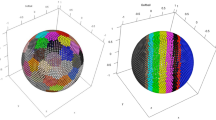Abstract
Nowadays, an increasing number of problems involve data with one infinite continuous dimension known as functional data. In this paper, we introduce the funLOCI algorithm, which enables the identification of functional local clusters or functional loci, i.e, subsets or groups of curves that exhibit similar behavior across the same continuous subset of the domain. The definition of functional local clusters incorporates ideas from multivariate and functional clustering and biclustering and is based on an additive model that takes into account the shape of the curves. funLOCI is a multi-step algorithm that relies on hierarchical clustering and a functional version of the mean squared residue score to identify and validate candidate loci. Subsequently, all the results are collected and ordered in a post-processing step. To evaluate our algorithm performance, we conduct extensive simulations and compare it with other recently proposed algorithms in the literature. Furthermore, we apply funLOCI to a real-data case regarding inner carotid arteries.












Similar content being viewed by others
Code Availibility
The R code implementing the procedure and the data used in the case studies are available at https://github.com/JacopoDior/funLOCI.
References
Bataineh, K. M., Naji, M., Saqer, M. (2011). A comparison study between various fuzzy clustering algorithms. In: Jordan Journal of Mechanical & Industrial Engineering 5.4
Bouveyron, C., & Jacques, J. (2011). Model-based clustering of time series in group-specific functional subspaces. Advances in Data Analysis and Classification, 5, 281–300.
Cheng, Y., Church, G. M. (2000). Biclustering of expression data. In: Ismb. vol. 8. 2000, pp. 93–103
Cremona, M. A., Chiaromonte, F. (2023). Probabilistic k-means with local alignment for clustering and motif discovery in functional data. In: Journal of Computational and Graphical Statistics, pp. 1–12
Dümbgen, L. (2002). Application of local rank tests to nonparametric regression. In: Journal of Nonparametric Statistics 14.5, pp. 511–537
Ferraty, F., Vieu, P. (2006). Nonparametric functional data analysis: theory and practice. Springer Science & Business Media.
Floriello, D., & Vitelli, V. (2017). Sparse clustering of functional data. Journal of Multivariate Analysis, 154, 1–18.
Galvani, M., Torti, A., Menafoglio, A., Vantini, S. (2021). FunCC: a new bi-clustering algorithm for functional data with misalignment. In: Computational Statistics & Data Analysis 160, p. 107219
Huber, P. (1982). Krayenbühl/Yaşargil cerebral angiography. Georg Thieme Verlag
Jacques, J., Preda, C. (2014). Functional data clustering: a survey. In: Advances in data analysis and classification 8.3, pp. 231–255
James, G. M., Sugar, C.A. (2003). Clustering for sparsely sampled functional data. In: Journal of the American statistical association 98.462, pp. 397–408
Kaufman, L., Rousseeuw, P. J. (2009). Finding groups in data: an introduction to cluster analysis. vol. 344. John Wiley & Sons
Kokoszka, P., Reimherr, M. (2017). Introduction to functional data analysis. Chapman and Hall/CRC
Madeira, S. C., Oliveira, A. L. (2004). Biclustering algorithms for biological data analysis: a survey. In: IEEE/ACM transactions on computational biology and bioinformatics (TCBB) 1.1, pp. 24–45
Miyamoto, S., Ichihashi, H., Honda, K., Ichihashi, H. (2008). Algorithms for fuzzy clustering. vol. 10. Springer
Passerini, T., Sangalli, L. M., Vantini, S., Piccinelli, M., Bacigaluppi, S., Antiga, L., Boccardi, E., Secchi, P., Veneziani, A. (2012). An integrated statistical investigation of internal carotid arteries of patients affected by cerebral aneurysms. In: Cardiovascular engineering and technology 3.1, pp. 26–40
Ramsay, J. O., & Silverman, B. W. (2007). Applied functional data analysis: Methods and case studies. Springer.
Ramsay, J., & Wickham., H. Graves., S., Hooker, G. (2010). fda: Functional Data Analysis. R package version, 2(2), 6.
Rand, W. M. (1971). Objective criteria for methodsthe evaluation of clustering. In: Journal of the American Statistical association 66.336, pp. 846–850
Sangalli, L. M., Secchi, P., Vantini, S., Veneziani, A. (2009). A case study in exploratory functional data analysis: Geometrical features of the internal carotid artery . In: Journal of the American statistical association 104.485, pp. 37–48
Sangalli, L. M., Secchi, P., Vantini, S., Vitelli, V. (2012). Joint clustering and alignment of functional data: An application to vascular geometries. In: Advanced statistical methods for the analysis of large data-sets. Springer, pp. 33–43
Tokushige, S., Yadohisa, H., & Inada, K. (2007). Crisp and fuzzy k-means clustering algorithms for multivariate functional data. Computational Statistics, 22, 1–16.
Vitelli, V. (2019). A novel framework for joint sparse clustering and alignment of functional data. In: arXiv:1912.00687
Yang, M.-S. (1993). A survey of fuzzy clustering. In: Mathematical and Computer modelling 18.11, pp. 1–16
Author information
Authors and Affiliations
Corresponding author
Ethics declarations
Conflict of interest
The authors declare no competing interests.
Ethical Conduct
This research does not contain any studies with human participations or animals performed by any of the authors.
Additional information
Publisher's Note
Springer Nature remains neutral with regard to jurisdictional claims in published maps and institutional affiliations.
Rights and permissions
Springer Nature or its licensor (e.g. a society or other partner) holds exclusive rights to this article under a publishing agreement with the author(s) or other rightsholder(s); author self-archiving of the accepted manuscript version of this article is solely governed by the terms of such publishing agreement and applicable law.
About this article
Cite this article
Di Iorio, J., Vantini, S. funLOCI: A Local Clustering Algorithm for Functional Data. J Classif (2023). https://doi.org/10.1007/s00357-023-09456-w
Accepted:
Published:
DOI: https://doi.org/10.1007/s00357-023-09456-w




